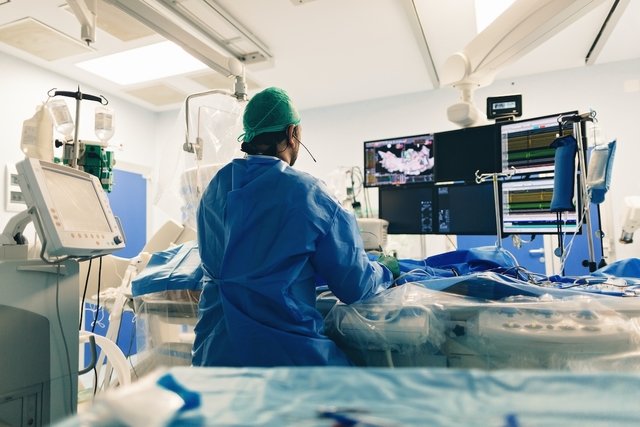The electrophysiological study is a diagnostic test that uses electrodes and computerized equipment, which allows identifying and recording the electrical activity of the heart, to check changes in the heart rhythm.
This exam is normally requested by the cardiologist, to diagnose cardiac arrhythmias, or causes of syncope or palpitations, but it can also be requested to evaluate treatment with antiarrhythmic medications or the functioning of the implantable defibrillator, for example.
The electrophysiological study is a simple procedure and lasts around 1 hour, however, it is carried out in the surgical center with local anesthesia and sedation, as it involves the introduction of catheters through the femoral vein, located in the groin region, or jugular vein in the groin. neck, and which have direct access to the heart, allowing the study to be carried out.

What is it for
The electrophysiological study is normally indicated for:
- Investigate the cause of faintingdizziness and accelerated heartbeat;
- Investigate changes in heartbeat rhythmalso known as arrhythmia;
- Identify the cause of cardiac arrhythmia to perform the ablation;
- Investigate for bradyarrhythmiaswhich are irregular or slow heartbeats;
- Diagnose sinus node dysfunction;
- Help with diagnosis and determine the location of the atrioventricular block;
- Investigate hereditary primary arrhythmia syndromessuch as long QT syndrome, short QT syndrome, Brugada syndrome, or catecholaminergic polymorphic ventricular tachycardia;
- Assess the heart before pacemaker implantation;
- Check operation of the implantable defibrillatorwhich is a device similar to a pacemaker.
The electrophysiological study aims to verify the function of each part of the heart’s electrical impulse conduction system, identify their changes and location, in addition to evaluating the risks of arrhythmia and determining the best treatment, which may include medication or ablation, for example .
Thus, based on the results obtained through the electrophysiological study, the cardiologist can recommend carrying out other tests or starting treatment more focused on the cardiac alteration.
How to prepare
To carry out the electrophysiological study, some precautions are necessary for its preparation, such as:
- Clarify all doubts talk to the doctor about the exam and risks;
- Tell your doctor if you have an allergy to anesthetics or any other medicine, food, latex or iodine, before taking the exam;
- Bring a list of all medicationsvitamins and nutritional supplements that are taken frequently;
- Tell if you are pregnant or suspected pregnancy, in the case of women;
- Inform your doctor about the use of anticoagulant medicationssuch as warfarin, heparin, rivaroxaban or acetylsalicylic acid, as the doctor may recommend stopping the medication a few days before the exam;
- Inform if you have health problemssuch as blood clotting disorders or diabetes;
- Absolute fasting approximately 6 to 8 hours before the exam;
- Take your usual medicines normallywith little water, as per medical advice.
Furthermore, before carrying out the electrophysiological study, the doctor must request tests such as a complete blood count with platelets, to assess blood clotting, and an electrocardiogram.
How is done
The electrophysiological study is carried out in the hospital, by the cardiologist by inserting a catheter into the femoral vein, which is the vein located in the groin, or the jugular vein, located in the neck.
To carry out the electrophysiological study, the doctor must follow some steps, such as:
- Groin waxingif the catheter is inserted in this region;
- Cleaning the region with an antiseptic;
- Application of local anesthetic in the region where the catheter will be inserted, in order to reduce discomfort;
- Application of saline solution into the veinso that the doctor can inject the sedative or other medications during the exam;
- Introduction of a catheter thin and flexible in the jugular vein or femoral vein, guided by the X-ray, until it reaches the heart;
- Carrying out the study of the electrical impulses of the heartin which electrical impulses are emitted to the heart through electrodes present at the tip of the catheter, which allow the doctor to evaluate how the electrical signals spread in the heart during each heartbeat;
- Recording the electrical activity of the heart by the computer;
- Catheter removal;
- Carrying out a dressing at the site where the catheter was inserted.
The electrophysiological study lasts about 1 hour, and the results of the exam must be evaluated by the cardiologist, in order to decide whether any other type of treatment is necessary and which treatment is most appropriate, such as using or changing medications, placing a pacemaker or defibrillator. implantable, for example.
Electrophysiological study with ablation
The electrophysiological study with ablation corresponds to the procedure in which, at the same time as the study is carried out, treatment for the cardiac alteration is carried out, which consists of ablation.
Ablation consists of the introduction of a catheter, through the same entry route into the body as the catheters used during the study, which reaches the heart.
The end of this catheter is made of metal and when it comes into contact with the heart tissue, it is heated and causes small burns in the area that are capable of removing the faulty electrical signaling pathway that is related to the heart change.
After carrying out the ablation, a new electrophysiological study is normally carried out with the aim of checking whether there was a change in any other cardiac electrical signaling pathway during the ablation.
Care after the study
After the electrophysiological study, you must remain in the hospital under medical care, and the person must remain lying down for around 2 to 6 hours, depending on each case. If the catheter has been inserted into the groin, it is recommended not to bend the leg for a few hours.
During hospitalization, the person is monitored by the nurse by assessing heart rate and blood pressure, observing the place where the catheter was inserted, and evaluating blood circulation.
When you are discharged from hospital, you should observe at home the presence of bleeding in the place where the catheter was inserted, and clean the area with soap and water, in addition to keeping your skin always clean and dry.
Furthermore, it is important to follow all medical recommendations, avoid physical activity or exertion for at least a week, take the prescribed medications at the correct times and eat a healthy diet. See the main foods that are good for the heart.
When it should not be done
The electrophysiological study should not be carried out in suspected or confirmed cases of pregnancy, bloodstream infection or sepsis, or infection or thrombosis at the site of the blood vessel where the catheter will be inserted.
Furthermore, this test is not recommended in cases of blood clotting problems, acute decompensated heart failure not caused by arrhythmia.
Possible complications
The electrophysiological study is a safe test, generally not causing complications during the procedure.
However, some complications may arise, such as:
- Bruising or bleeding at the catheter insertion site;
- Infection at the site where the catheter was inserted;
- Perforation or damage to the cardiac tissue by the catheter, which may cause bleeding;
- Damage to heart valves or vessels;
- Damage to the heart’s electrical conduction system;
- Thrombosis or formation of blood clots in the legs or lungs;
- Heart attack;
- Stroke or stroke.
Furthermore, in rare cases, allergic reactions may occur to the anesthetic or sedative used to perform the electrophysiological study.
The risks of the electrophysiological study are minimal when the exam is scheduled, in addition, it is usually carried out in well-equipped cardiology reference hospitals, containing cardiologists and cardiac surgeons, prepared for possible complications.

Sign up for our newsletter and stay up to date with exclusive news
that can transform your routine!
Warning: Undefined array key "title" in /home/storelat/public_html/wp-content/plugins/link-whisper-premium/templates/frontend/related-posts.php on line 12
Warning: Undefined array key "title_tag" in /home/storelat/public_html/wp-content/plugins/link-whisper-premium/templates/frontend/related-posts.php on line 13



